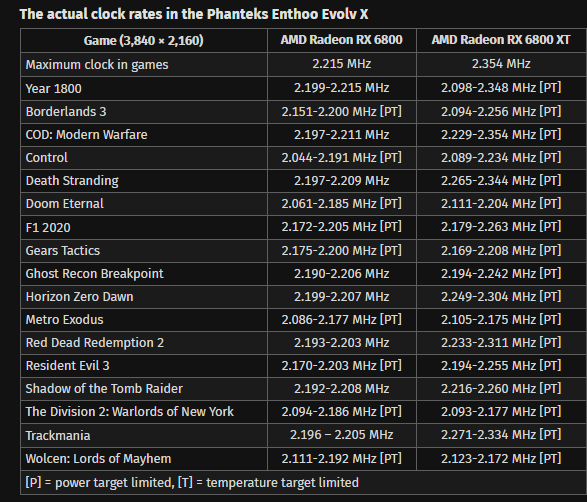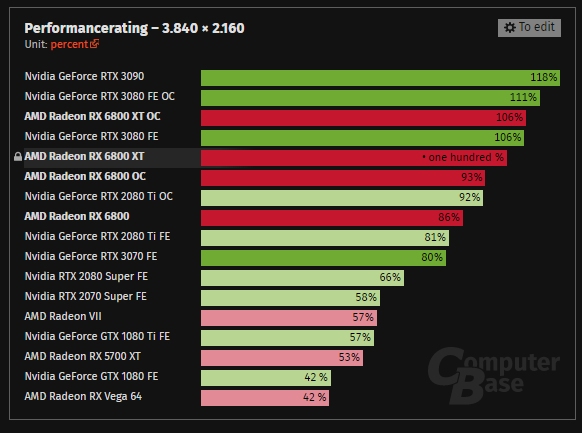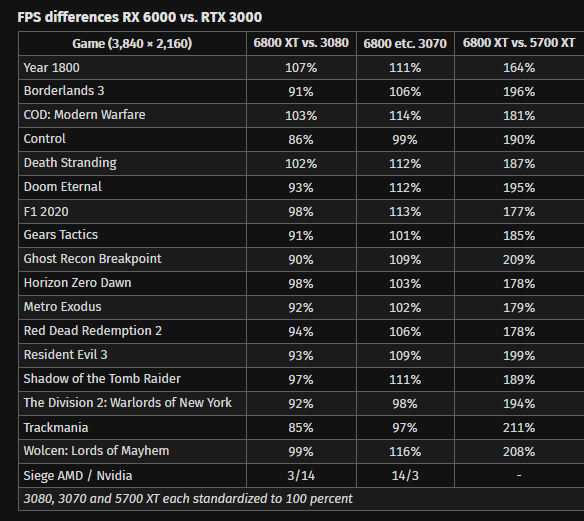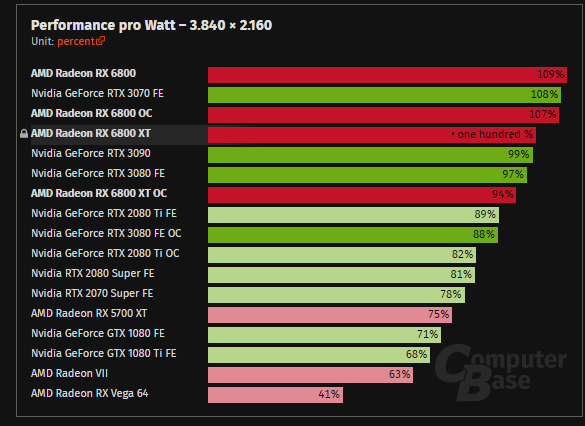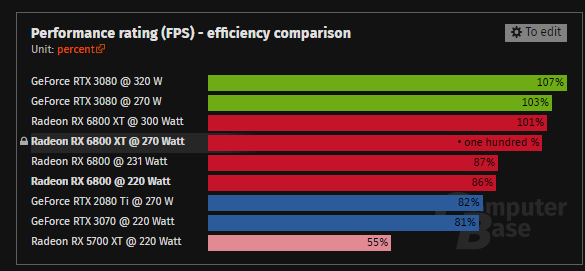You are using an out of date browser. It may not display this or other websites correctly.
You should upgrade or use an alternative browser.
You should upgrade or use an alternative browser.
AMD Radeon RDNA2 Navi (RX 6500, 6600, 6700, 6800, 6900 XT)
DavidGraham
Veteran
6800XT is slightly slower than 3080 in rasterization, but massively slower in Ray Tracing.
D
Deleted member 7537
Guest
So RDNA2 doesn't overclock, basically maintains a clock in a 50-100mhz range and it's power consumption what really varies. Which is very aligned with what PS5 does, and at even higher clocks.

2.3 Ghz is quite impressive, not near those 2.5 Ghz rumored but quite good.
Also, I've just realized that XSX is really the only RDNA2 based GPUs with 14 CUs per SA. The rest of them including the PS5 have 10. I wonder what are the pros and cons of the approach.
Unless they manage to produce enough to meet demands and lower the price seems like a hard pass.

2.3 Ghz is quite impressive, not near those 2.5 Ghz rumored but quite good.
Also, I've just realized that XSX is really the only RDNA2 based GPUs with 14 CUs per SA. The rest of them including the PS5 have 10. I wonder what are the pros and cons of the approach.
6800XT is slightly slower than 3080 in rasterization, but massively slower in Ray Tracing.
Unless they manage to produce enough to meet demands and lower the price seems like a hard pass.
Last edited by a moderator:
D
Deleted member 13524
Guest
Lol, these reviews are fucked. Has anyone actually benchmarked ray tracing extensively? Hardware Unboxed tested a total of two games ... lol. Gamers Nexus test a few, *corrected they do show no dlss for nvidia *
What's confusing is the fact that most reviewers seem to be pairing these new graphics cards with older Intel CPUs without PCIe 4.0. GamerNexus used a Comet Lake 10700K, and TPU used a 2 year-old Coffee Lake 9900K.
Both these outlets have Zen3 CPUs, we have their Zen3 reviews from a month ago.
Why are they doing that? So they can reuse the results they got from earlier reviews?
Besides, is SAM even working on these CPUs, and is it supposed to make a difference on PCIe 3.0 links?
Rootax
Veteran
gurud3d says SAM does things for only one game in their review https://www.guru3d.com/articles_pages/amd_radeon_rx_6800_xt_review,30.html
And you need to be in UEFI btw, doesn't work in bios/csm mode.
And you need to be in UEFI btw, doesn't work in bios/csm mode.
We did some things with the 3DMark Feature test: With increasing sample count the gap between RX 6800 XT and RTX 3070 lessens. edit: I should add, that in traditional rasterization, there's another gap, in the opposite direction and it's b i g.Lol, these reviews are fucked. Has anyone actually benchmarked ray tracing extensively? Hardware Unboxed tested a total of two games ... lol. Gamers Nexus test a few, *corrected they do show no dlss for nvidia *
Officially: Ryzen 5k with supported BIOSes only atm.Besides, is SAM even working on these CPUs, and is it supposed to make a difference on PCIe 3.0 links?
This is basically why. They don't want to have to perform all their extensive benchmarking all over again on a new platform. Hardware Unboxed moved to Ryzen for their main benchmarking platform I believe.Why are they doing that? So they can reuse the results they got from earlier reviews?
Our review will of course have tested ray tracing.
Considering the future of graphics (and especially in PC versions of games) is ray tracing - I think it is an important performance point.
Thanks DF for existing.
DavidGraham
Veteran
The more Ray Tracing effects in the game, the more RDNA2 gets hammered in RT performance. Games that have only RT shadows for example perform reasonably less bad, but add in AO, reflections .. etc and it gets worse fast.
Man from Atlantis
Veteran
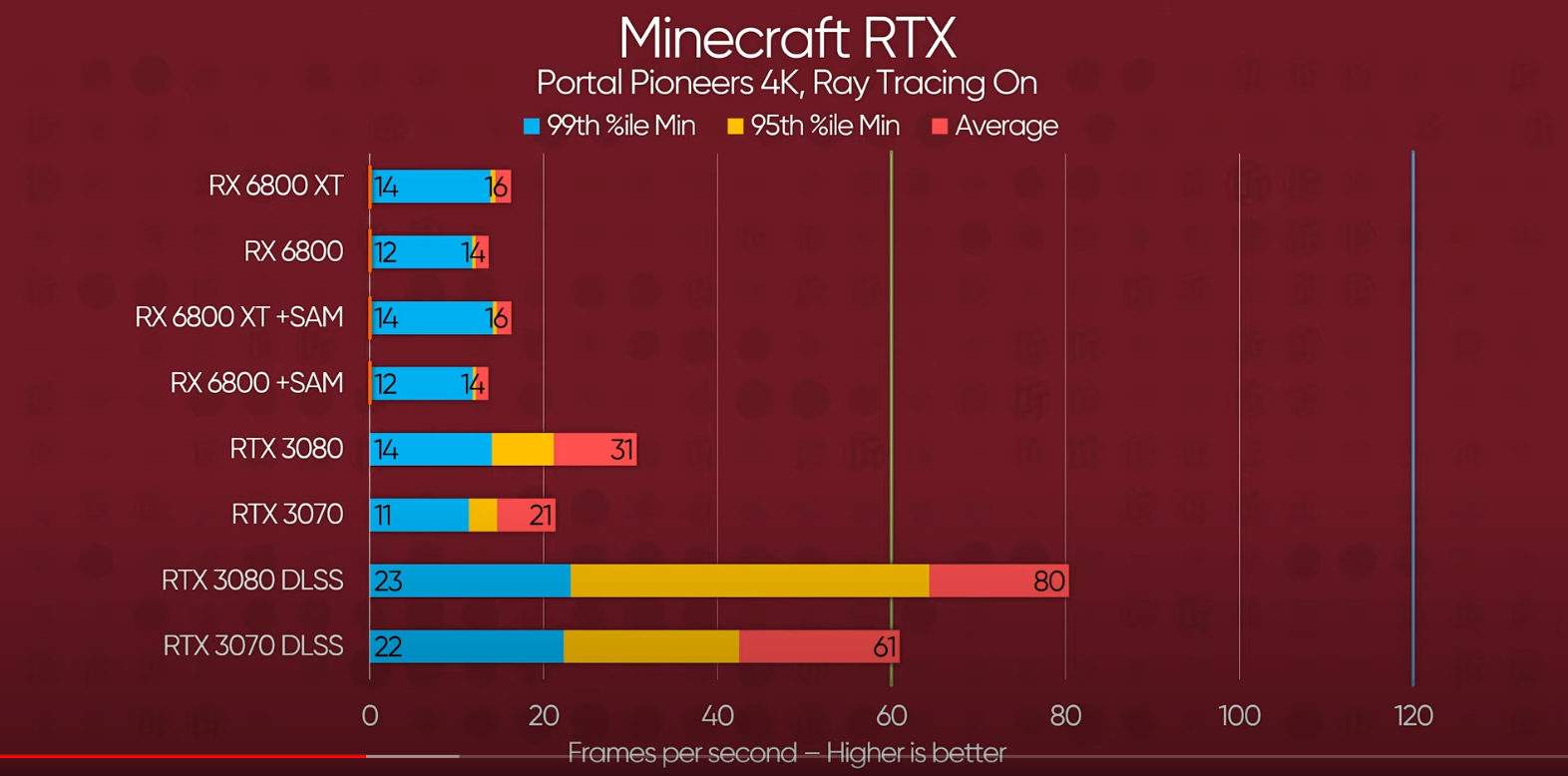
Linus
D
Deleted member 7537
Guest
DLSS is a pointless comparison as not even most games support this feature. It's apples to oranges.
Hardware Unboxed used the Ryzen 9 3950 and will be moving to the 5950 in a couple of weeks when they have time, according to their review.This is basically why. They don't want to have to perform all their extensive benchmarking all over again on a new platform. Hardware Unboxed moved to Ryzen for their main benchmarking platform I believe.
Leoneazzurro5
Regular
The more Ray Tracing effects in the RTX optimized games, the more RDNA2 gets hammered in RT performance. Games optimized for AMD or that have only RT shadows for example perform reasonably good, but add in AO, reflections .. etc and it may get worse fast.
Fixed
My colleague wrote something fresh off of our Ryzen-9-5900X-plattform: https://www.heise.de/tests/AMD-Graf...-GeForce-RTX-3080-auf-den-Fersen-4964312.htmlBoth these outlets have Zen3 CPUs, we have their Zen3 reviews from a month ago.
Why are they doing that? So they can reuse the results they got from earlier reviews?
Rootax
Veteran
DLSS is a pointless comparison as not even most games support this feature. It's apples to oranges.
If a game you bench support it, it's a good thing to show the perfs with it imo (as long as you show without it too).
In a way it the same as SAM; the large majority of users won't have a compatible cpu but is nice to see the performance differences (in a separate section).If a game you bench support it, it's a good thing to show the perfs with it imo (as long as you show without it too).
If a game you bench support it, it's a good thing to show the perfs with it imo (as long as you show without it too).
Even without DLSS in that graph, the 3080 is quite much faster then a 6800XT to begin with. Heck, even in normal rendering the 3080 is the faster GPU. Then, when compute heavier games/next generation games start to appear that gap may even grow bigger (3080 is 30TF compute).
Aside from that, we have ray tracing, its the feature going forward, seeing just about every game having it, even on consoles. Your not going to spend 500 dollars or more and play next gen games without it?
DLSS is a total different matter, even more so then anything else, as you basically get a extremely huge uplift in performance. It goes hand in hand with ray tracing, and enables 8k gaming in the future (3090 showcased 8k 60?).
4k doesnt seem to friendly either to the new amd gpus.
But, AMD has made strides, their GPUs are more competitive now then before. I think last time they where competitive was 2012/2013 (HD7950 vs 670 etc).
RDNA3 will come closer, 4 even more etc. Things dont go all at once like that, since competition rarely is sitting still.
Anyway, myself i wont be getting anything now, my 2080Ti is over next gen baseline and stocks are bad. Next year might see a 3080 refresh with either a zen3 or rocket lake cpu.
RX 6000 Pros:
best-in-class 1080p/1440p performance thanks to infinity cache
excellent rasterization performance
SAM is a great idea but doesn't move the bar (haha) much
16GB VRAM across the product line
RTX 3000 Pros:
4k performance
ray-traced performance
DLSS
fewer game-breaking driver issues (historically)
We can all see why AMD didn't include any ray-tracing performance numbers in their announcement event. I'm not surprised, sometimes silence speaks volumes. I will be waiting for a (hopefully) 3080 Ti launch soon.
best-in-class 1080p/1440p performance thanks to infinity cache
excellent rasterization performance
SAM is a great idea but doesn't move the bar (haha) much
16GB VRAM across the product line
RTX 3000 Pros:
4k performance
ray-traced performance
DLSS
fewer game-breaking driver issues (historically)
We can all see why AMD didn't include any ray-tracing performance numbers in their announcement event. I'm not surprised, sometimes silence speaks volumes. I will be waiting for a (hopefully) 3080 Ti launch soon.
Similar threads
- Replies
- 27
- Views
- 11K


